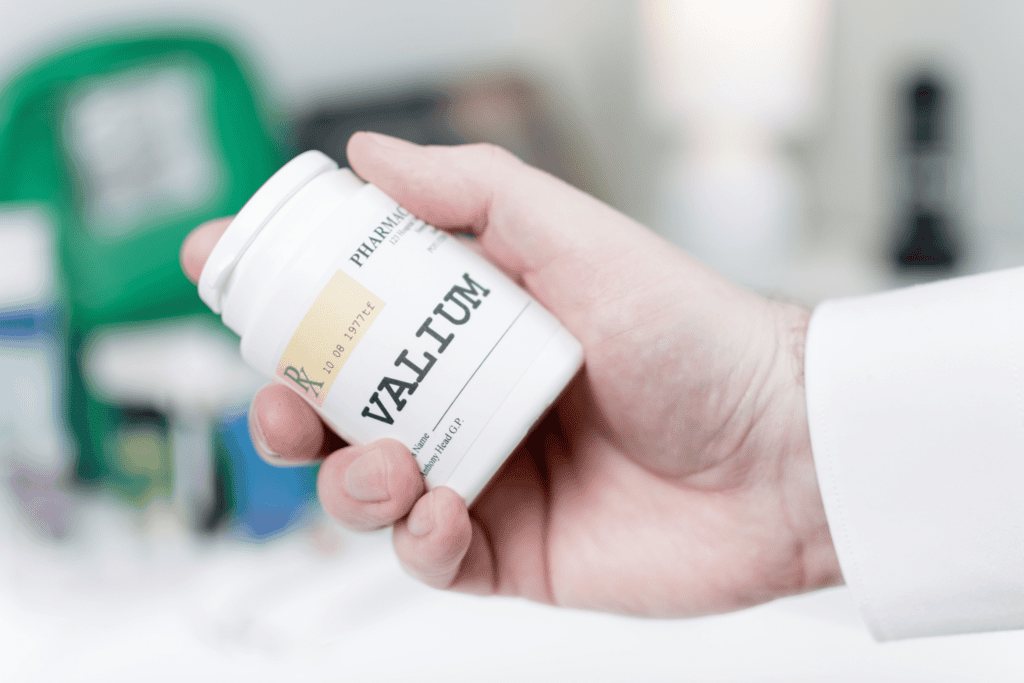
Home » Drug Addiction » Benzo Addiction » Valium Addiction and Abuse: Signs, Effects, and Treatment
VALIUM ADDICTION AND ABUSE: SIGNS, EFFECTS, AND TREATMENT

Valium Addiction
Valium is a branded form of diazepam, a benzodiazepine and CNS (central nervous system) depressant prescribed for the treatment of anxiety disorder and alcohol withdrawal.
Diazepam can be effective when used short-term and as directed, but it can also trigger adverse effects that include tolerance, dependence, withdrawal symptoms, addiction, and addiction.
If you or a loved one is prescribed Valium, this guide will help you to familiarize yourself with the potential adverse effects of Valium and will also show you how to effectively detox from Valium and engage with ongoing treatment.

What is Valium?
Valium is a long-acting benzo that may reduce the symptoms of anxiety. Diazepam also acts as a sedative, anticonvulsant, and muscle relaxant
Like other benzos, Valium streamlines the action of GABA (gamma-aminobutyric). GABA is an neurotransmitter or chemical messenger in the central nervous system. This mechanism of action may help calm an overstimulated CNS.
When taken as prescribed, Valium can be effective in the short-term. Due to its habit-forming potential and euphoric effects, Valium is also frequently misused. Misuse of Valium involves taking more of the medication than prescribed or taking the medication without a prescription.
Those who misuse benzos typically take higher doses than prescribed, commonly combining benzodiazepines with other substances like alcohol or opioids. Some people misuse Valium by swallowing tablets. Others crush Valium tablets and snort the powder.
Valium is classified by the DEA as a Schedule IV controlled substance for its potential for misuse and dependence.

Get The Help You Need Today
Gratitude Lodge Drug & Alcohol Addiction Treatment
What Are The Side Effects of Valium?
Common Valium side effects include:
- Fatigue
- Drowsiness
- Muscle weakness
- Problems with balance
- Impaired muscle movement
Seek emergency medical assistance if you develop signs of an allergic reaction to Valium. This may involve the presentation of hives, breathing, problems, or swelling of your face, tongue, lips, or throat.
Diazepam may slow or even stop your breathing, especially when combined with alcohol or opioids. If you have taken Valium and your breathing slows, your lips turn a blue color, or you are hard to wake, someone should call for emergency medical attention.
You should consult your prescribing physician if you experience the following when taking Valium:
- Panic attacks
- New episodes of depression
- Worsening depression
- Insomnia
- Irritability
- Agitation
- Aggression
- Confusion
- Paranoia
- Severe dizziness
- Extreme drowsiness
- Breathing difficulties
- Seizure
- Suicidal thoughts
In seniors, dizziness or drowsiness may last longer. Exercise caution to minimize the likelihood of slips, falls, and accidental injuries.
Addiction to Valium can progress rapidly if the drug is not used exactly as directed. Despite this, many people become addicted to this potent benzo without realizing a problem is developing.
Taking diazepam for more than 4 to 6 weeks – even with an accompanying prescription – will heighten your risk of developing an addiction to benzos.
Why Is Valium Prescribed?
Valium is approved by the FDA for:
- Short-term treatment of anxiety
- Treating convulsive disorders and muscle spasms and
- Relieving the symptoms of acute alcohol withdrawal
Valium is abused for many non-medical purposes, either in isolation or in combination with other substances like alcohol, opioids, or cocaine.
Valium Is Used To Treat
- Anxiety
- Muscle Spasms
- Convulsions
- Alcohol Withdrawal
Short Term Effects Of Valium Abuse
As a long-acting benzodiazepine, Valium stays in the system for much longer than benzos like Halcion (a short-acting benzodiazepine). Ingested orally up to 4 times a day, taking Valium regularly will precipitate tolerance and dependence. Some of the most common side effects of Valium include:
- Dry mouth
- Changes to heart rhythm or rate
- Slowed breathing
- Blurred vision
- Confusion
- Nausea
- Dulled reflexes
- Appetite changes
- Memory loss
- Impaired coordination
- Slurred speech
The sustained abuse of Valium leads to tolerance and physical dependence forming. Chronic abuse of this substance often brings about addiction.
Valium can induce a euphoric high and pleasant sedation, both of which may motivate the sustained abuse of this medication. Using Valium may also trigger the following desirable effects in those abusing diazepam:
- Intense euphoria
- Reduced stress
- Drowsiness
- Increased physical and mental relaxation
Beyond this, many Valium side effects worsen with the sustained use of the benzodiazepine. These side effects may include:
- Nausea
- Headaches
- Constipation
- Dizziness
- Confusion
- Low blood pressure
- Blurred vision
- Slurred speech
- Tremors
- Problems urinating
Diazepam abuse may also bring about adverse effects to mental health. The most reported side effects include:
- Anger
- Agitation
- Irritability
- Anxiety
- Delusions
- Hallucinations
- Nightmares
- Insomnia
- Disrupted sleep patterns
Valium can be abused even by those prescribed the medication for medical purposes. Valium abuse may involve:
- Taking more Valium than prescribed.
- Takes more frequent doses of Valium than prescribed.
- Takes Valium without a prescription for its euphoric high.
- Using someone else’s Valium prescription.
- Combining Valium with other substances to modify or enhance the effects.
Any abuse of Valium may bring about adverse effects to physical and mental health, and it may be fatal. The risks are intensified when you combine Valium with CNS depressants like opioids, alcohol, barbiturates, or prescription sleep aids.
Long Term Risks
The long-term abuse of Valium can adversely impact your health and overall well-being. These are the most significant risks:
- Tolerance: Tolerance forms with the sustained use of many substances, including opioids, alcohol, and benzos like Valium. As your body adapts to the consistent presence of Valium over time, the original dose will not produce the same results. This often prompts the need to increase the dose or frequency of Valium use.
- Dependence: If you continue taking Valium long-term, your body will become accustomed to its presence, coming to require the substance to function normally. Dependence can occur even when Valium is taken as directed by a prescribing physician. Physical dependence will result in the presentation of benzo withdrawal symptoms if you moderate or discontinue the use of Valium. Dependence often but not always leads to addiction.
- Withdrawal: If you become physically dependent on Valium, you will experience uncomfortable and potentially life-threatening withdrawal symptoms when you stop using the medication or dramatically decrease your dose. The avoidance of withdrawal often leads people to continue abusing benzos. Withdrawal symptoms may include depressed mood, severe anxiety, panic attacks, insomnia, headaches, muscle cramps, restlessness, sweating, vomiting, hallucinations, and seizures.
- Addiction: Addiction is frequently confused with physical dependence. While dependence is oftentimes indicative of the potential development of Valium addiction, dependence and addiction are not synonymous concepts. Physical dependence describes your body’s reliance on a drug, whereas addiction is characterized by the compulsive desire to obtain and use a drug regardless of negative outcomes. Those with Valium addictions will continue using the benzo even though it is causing problems at home, work, or school, and despite the associated physical and mental health complications.
SIGNS AND SYMPTOMS of Valium Abuse
Most research into the side effects triggered by Valium concerns lawfully prescribed use, but the same effects manifest when Valium is misused or abused. These include:
- Social Isolation
- Strong cravings
- Drowsinzess
- Dizziness
- Slowed Breathing
- Weakness
- Blurred Vision
- Irregular Heartbeat
- Confusion
- Skin Rash
- Seizures
Don’t Let Valium Addiction Control You
Break Addiction With Gratitude Lodge
Symptoms and Side Effects of Valium Use
The symptoms of Valium addiction are clearly delineated in DSM-5-TR, the most recent update of APA’s benchmark diagnostic tool. Addiction is a non-clinical descriptor for substance use disorder. Substance use disorder applies to all disorders related to drugs, although there are also several sub-categories. Addiction to Valium is clinically known as sedative use disorder.
To be diagnosed with substance use disorder, at least two of the eleven symptoms outlined in DSM-5 must present within a year. Substance abuse disorder and Valium addiction, then, involve more than just episodic drug abuse.
According to the number of the following symptoms present, diagnosis of substance use disorder can be mild, moderate, or severe.
- Spending large chunks of time obtaining, using, and recovering from Valium.
- Repeatedly using Valium in dangerous situations – driving under the influence of benzos, for example.
- Reducing social commitments in favor of Valium use.
- Failing to meet commitments and obligations due to abuse of Valium.
- Experiencing strong cravings for Valium.
- Using Valium even though it is causing or inflaming health conditions.
- Taking more Valium than intended or using Valium more often than planned.
- Trying and failing to moderate or discontinue use of Valium.
- Developing a tolerance for benzodiazepines.
- Encountering withdrawal symptoms when the effects of Valium wear off.
- Continuing to use Valium despite these negative outcomes.
If you use Valium long-term, you also run the risk of developing co-occurring disorders. As an example, Valium is routinely used to treat the symptoms of anxiety. Over time, your brain starts to rely on the substance to regulate stress levels. In the absence of the drug, this imbalance in the brain can trigger anxiety or depressive disorders not previously existent.
Long-term Valium abuse can cause damage to areas of the brain responsible for cognition and memory.
Valium Withdrawal
Benzodiazepine withdrawal typically unfolds over two stages. These stages are differentiated by the intensity and number of symptoms, as well as the duration of withdrawal.
The first stage of detox is acute Valium withdrawal. This begins from 1 to 4 days after the last use of the medication. Valium has a variable elimination half-life of up to 48 hours, meaning that some people may experience no significant symptoms of withdrawal until the third or fourth day of Valium detox. The onset of withdrawal symptoms varies depending on the frequency and scope of Valium use, the use of other addictive substances, and unique differences in psychological stability and metabolism. In those prone to depression and anxiety, rebound anxiety may present. This involves a return of the anxiety present before the initiation of Valium therapy.
The symptoms of acute Valium withdrawal typically include a combination of:
- Physical symptoms: Headaches, vomiting, nausea, cramps, stomach pains, and tremors.
- Cardiovascular symptoms: Either associated with rebound anxiety or part of the withdrawal process (increased heart rate and blood pressure).
- Neurological symptoms: Confusion and potential development of life-threatening seizures.
- Psychological symptoms: Mood swings, cravings, panic attacks, depression, and rebound anxiety.
Following the first four days of acute Valium withdrawal, a more protracted general withdrawal phase occurs, typically continuing for between 10 and 14 days. This period is characterized by increased cravings for Valium, headaches, lightheadedness, periods of nausea, mild fever, chills, depression, and continuing episodes of anxiety. The symptoms will be much less intense than acute Valium withdrawal symptoms.
PAWS (post-acute withdrawal syndrome) is a more protracted period of generalized psychological symptoms encountered by some people with severe Valium addictions. The symptoms of PAWS may persist for months or even years after discontinuing the use of benzos, increasing the likelihood of relapse during recovery.
Detox From Valium
Valium is frequently used as a replacement medication to streamline withdrawal from other benzos. Those who are physically dependent on another type of benzodiazepine may be administered Valium to replace that benzo, with the dosage then slowly tapered to allow you to adjust gradually. Once the Valium dosage reaches a certain level, the benzo is discontinued, and you will have negotiated the withdrawal phase without encountering serious adverse effects.
Similarly, physicians may utilize a tapering strategy those physically dependent on Valium. This can be an effective strategy to mitigate withdrawal symptoms.
Other medications can also be effective during Valium withdrawal, including:
- SSRIs: Selective serotonin reuptake inhibitor antidepressants can be useful in some cases of Valium withdrawal, especially for addressing rebound anxiety.
- Melatonin: This hormone can alleviate symptoms of anxiety and may induce sleep. Melatonin may also help address tolerance and symptoms of Valium withdrawal.
- Anticonvulsants: These medications are beneficial in the event of seizures. Some types of anticonvulsants also seem to reduce withdrawal symptoms from Valium.
- Baclofen: This muscle relaxant can reduce cravings for various drugs of abuse, including benzos like Valium.

Start Recovering Today
Gratitude Lodge Drug & Alcohol Addiction Treatment
Valium Addiction Treatment
It is never advisable to suddenly stop using Valium without medical supervision. When Valium withdrawal unfolds, adverse withdrawal symptoms can include coma, seizures, and death.
A professionally-managed tapered reduction can help mitigate many of the uncomfortable symptoms of withdrawal, while almost minimizing complications.
The most common Valium withdrawal symptoms are:
- Anxiety
- Insomnia
- Shakiness
The duration of detox and withdrawal from benzos like Valium will differ from person to person. Generally, the more Valium you take, the longer it will require to feel normal without the substance in your system.
In addition to medications to mitigate withdrawal symptoms and cravings, psychotherapy like CBT (cognitive behavioral therapy) can be effective for treating Valium addiction. A therapist will help you identify what triggers you to use Valium, and they will guide you to create superior healthy coping strategies rather than reaching for a pack of benzos.
Peer-support groups can also help many people grappling with a disorder like sedative use disorder after a prolonged period of Valium abuse.
Following the Valium detox process, ongoing treatment in an inpatient or outpatient setting is the next phase of recovery.
Inpatient rehab, also known as residential rehab, involves remaining at a residential facility for 30 to 90 days or more. Various pharmacological and behavioral interventions can help you to improve your physical and mental health. You will explore the root causes of your addiction to Valium, and you will also develop healthy coping mechanisms to help you cope without using Valium in your ongoing recovery.
Outpatient Valium rehab connects you with the same services and therapies as residential rehab. Between therapy sessions, you will return home or to a sober living community.
Recovery from Valium addiction is a long-term commitment that benefits from continual support. We can help you kickstart your recovery here at Gratitude Lodge in Orange County.
Valium Addiction Treatment At Gratitude Lodge
If you decide the time is right to engage with treatment for Valium addiction, severe sedative use disorders usually respond most favorably to inpatient treatment. Research suggests that intensive outpatient treatment is equally effective for most mild and moderate addictions, though. Access both 30-day inpatient programs and intensive outpatient programs at Gratitude Lodge treatment centers located in:
- Long Beach
- Newport Beach
- San Diego
Regardless of the level of treatment intensity that makes the best fit, you should find that a tapered reduction combined with medication-assisted treatment, psychotherapy, and counseling helps you leave Valium behind for good.
Call admissions today at 800-994-2184 for immediate assistance with Valium detox and rehab.

DRUGS & Abuse Disorders WE TREAT
Click on the Addiction to learn more!
Our Partners
WE ACCEPT MOST PPO INSURANCE
Valium Addiction FAQs
Valium, a branded form of diazepam, is a medication that belongs to the benzodiazepine class of drugs. Valium is prescribed to treat anxiety, seizures, and muscle spasms. Beyond these legitimate medical applications, Valium is also routinely abused for its sedative effects. Misuse or abuse of Valium may involve taking larger or more frequent doses than prescribed or using Valium without a prescription. Some people also crush the pills and snort the powder, while others combine Valium with other substances like alcohol, opioids, or cocaine.
Valium addiction may develop when the medication is used repeatedly or in high doses over an extended period. Common signs of Valium addiction include increased tolerance, withdrawal symptoms when not using the benzo, unsuccessful attempts to quit, and continued Valium use despite adverse outcomes. Other symptoms might include drowsiness, confusion, slurred speech, impaired coordination, and memory problems. Long-term abuse of Valium can also lead to more severe effects, such as respiratory depression, coma, and even death.
Treatment for Valium addiction typically involves a combination of medication-assisted detoxification, behavioral therapy, and counseling. Medications like flumazenil can be used to manage withdrawal symptoms, while therapy can help you to identify and change problematic behaviors and thought patterns. Support groups like 12-step programs may also provide ongoing support and encouragement. In severe cases of addiction, inpatient treatment may be necessary to provide a structured and intensive approach to recovery. Less severe Valium addictions may respond positively to outpatient Valium rehab.
Valium abuse can trigger a range of negative physical and mental health effects. Some of the short-term risks of Valium abuse include drowsiness, dizziness, confusion, and impaired coordination. In more severe cases, Valium abuse can cause respiratory depression, coma, or even death. Long-term abuse of Valium can lead to addiction, memory problems, cognitive impairment, and changes in brain structure and function. It can also increase the risk of other health problems like liver damage, cardiovascular disease, and infectious diseases.
Valium abuse and addiction can be prevented by using the medication only as prescribed by a doctor, not sharing medications with others, and not using Valium for non-medical purposes. It is also vital to be aware of the signs of Valium addiction and to seek help if required. Practicing stress management techniques – exercise, meditation, or therapy, for instance – may also help reduce the risk of developing anxiety or other conditions that may provoke Valium use. Additionally, avoiding other substances like alcohol or opioids while taking Valium will reduce the risk of dangerous drug interactions and addiction.
Yes, it is possible to overdose on Valium, especially when the drug is abused or taken in combination with other substances such as alcohol or opioids. Overdose symptoms may include severe drowsiness, confusion, impaired coordination, slowed breathing, and loss of consciousness. In some cases, Valium overdose can be life-threatening and require emergency medical intervention.
Withdrawal symptoms of Valium can be severe and uncomfortable, and may include anxiety, insomnia, irritability, restlessness, sweating, tremors, and seizures. The severity and duration of withdrawal symptoms may vary depending on the duration and intensity of Valium abuse, as well as individual factors such as age, overall health, and genetics. Withdrawal symptoms typically begin within a few hours to a few days after the last dose of Valium and can last for several weeks or longer. It is important to seek medical supervision during Valium detoxification to manage withdrawal symptoms safely and effectively.
Yes, it is possible to overdose on Valium, especially when the drug is abused or taken in combination with other substances such as alcohol or opioids. Overdose symptoms may include severe drowsiness, confusion, impaired coordination, slowed breathing, and loss of consciousness. In some cases, Valium overdose can be life-threatening and require emergency medical intervention.
Yes, Valium use during pregnancy can harm the developing fetus and increase the risk of birth defects, miscarriage, premature birth, and neonatal withdrawal syndrome. Neonatal withdrawal syndrome can occur when a baby is exposed to Valium or other benzodiazepines in utero, and may cause symptoms such as irritability, tremors, feeding difficulties, and respiratory problems. Valium should not be used during pregnancy unless absolutely necessary and under close medical supervision. Women who are pregnant or planning to become pregnant should talk to their doctor about the risks and benefits of using Valium.
Valium works by enhancing the activity of a neurotransmitter called GABA (gamma-aminobutyric acid), which has a calming effect on the brain and nervous system. By increasing GABA activity, Valium can reduce anxiety, muscle spasms, and seizures. That said, long-term abuse of Valium can alter the brain’s chemistry and structure, leading to changes in mood, behavior, and cognitive function. Chronic Valium use can also lead to tolerance, dependence, and addiction, which can further alter brain function and increase the risk of withdrawal symptoms and relapse.
Yes, there are several alternative medications and non-pharmacological treatments for anxiety or muscle spasms that can be used instead of or in conjunction with Valium. For anxiety, doctors may recommend other benzodiazepines such as alprazolam or lorazepam, or non-benzodiazepine medications such as buspirone or SSRIs (selective serotonin reuptake inhibitors). Non-pharmacological treatments such as CBT (cognitive-behavioral therapy), relaxation techniques, or exercise may also be effective for managing anxiety. For muscle spasms, doctors may recommend other muscle relaxants like baclofen or tizanidine, or physical therapy to improve muscle strength and flexibility.
Although there is no cure for Valium addiction, it can be effectively managed through ongoing treatment and support. With the right combination of medications, therapy, and support, you can learn to manage your addiction, reduce cravings for Valium, and develop healthy coping strategies to use in your ongoing recovery. That said, addiction is a chronic and relapsing condition that requires ongoing care.

















